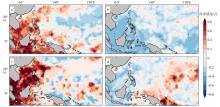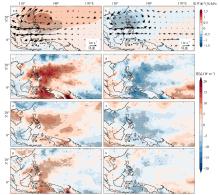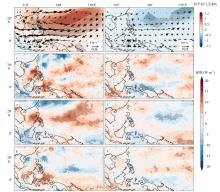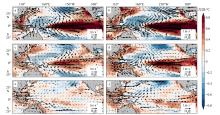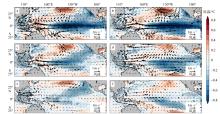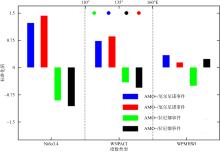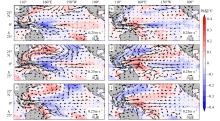热带海洋学报 ›› 2024, Vol. 43 ›› Issue (5): 1-16.doi: 10.11978/2023150CSTR: 32234.14.2023150
• 海洋水文学 • 下一篇
AMO对ENSO与初夏西太平洋海洋热浪年际关系的年代际调制作用*
袁钰1,2( ), 徐海明1,2(
), 徐海明1,2( ), 马静1,2, 张彤1,2
), 马静1,2, 张彤1,2
- 1.南京信息工程大学气象灾害预报预警与评估协同创新中心/气象灾害教育部重点实验室/气候与环境变化国际合作联合实验室, 江苏 南京 210044
2.南京信息工程大学大气科学学院, 江苏 南京 210044
-
收稿日期:2023-10-16修回日期:2023-12-14出版日期:2024-09-10发布日期:2024-10-10 -
作者简介:袁钰(1998—), 女, 新疆维吾尔自治区吉木乃县人, 硕士, 从事海气相互作用研究。email: yuanyu2024@163.com
*感谢3位匿名审稿人和编辑提出宝贵的意见。
-
基金资助:国家自然科学基金项目(42192562); 国家自然科学基金项目(41975106)
Impact of Atlantic Multidecadal Oscillation on interannual relationship between ENSO and early summer marine heatwaves in the Western Pacific*
YUAN Yu1,2( ), XU Haiming1,2(
), XU Haiming1,2( ), MA Jing1,2, ZHANG Tong1,2
), MA Jing1,2, ZHANG Tong1,2
- 1. Collaborative Innovation Center on Forecast and Evaluation of Meteorological Disasters (CICFEMD) / Key Laboratory of Meteorological Disaster, Ministry of Education (KLME) / Joint International Research Laboratory of Climate and Environment Change (ILCEC), Nanjing University of Information Science and Technology, Nanjing 210044, China
2. College of Atmospheric Science, Nanjing University of Information Science and Technology, Nanjing 210044, China
-
Received:2023-10-16Revised:2023-12-14Online:2024-09-10Published:2024-10-10 -
Supported by:National Natural Science Foundation of China(42192562); National Natural Science Foundation of China(41975106)
摘要:
海洋热浪是发生在海洋上的极端高温事件, 对海洋环境和生态系统具有破坏性影响。文章采用1960—2020年第五代欧洲中期天气预报中心再分析资料(European centre for medium-range weather forecasts reanalysis v5, ERA5)和英国气象局哈德来中心全球海冰和海洋表面温度资料集(Hadley centre global sea ie and sea surface temperature, HadISST)以及地球系统模式(community Earth system model, CESM1)北大西洋理想试验数据等, 通过相关、合成分析等多种统计方法, 研究了厄尔尼诺-南方涛动(El Niño-Southern Oscillation, ENSO)与次年初夏西太平洋海洋热浪年际关系的变化特征, 并进一步探讨了二者关系发生年代际变化的可能成因。研究结果表明: 1) ENSO与次年初夏西太平洋海洋热浪月数的年际关系具有明显的年代际变化特征, 北大西洋多年代际振荡(Atantic multidecadal oscillation, AMO)是二者年际关系发生年代际变化的主要成因。当AMO处于正位相时, ENSO与次年初夏西太平洋海洋热浪存在显著的正相关关系, 而当AMO处于负位相时, 上述二者相关关系不再显著; 2) AMO主要通过调控ENSO事件的强度进而影响西北太平洋大气环流的异常响应, 从而进一步影响ENSO与次年初夏西太平洋海洋热浪之间的关系。当AMO处于负(正)位相时, 相对较强(弱)的ENSO事件通过强(弱)风-蒸发-海温正反馈过程, 使得ENSO事件次年初夏西北太平洋地区产生位置相对偏东(西)、强度相对偏强(弱)的异常反气旋/气旋。异常反气旋/气旋的位置和强度导致初夏西太平洋海洋热浪的分布在AMO正、负位相存在显著差异。
引用本文
袁钰, 徐海明, 马静, 张彤. AMO对ENSO与初夏西太平洋海洋热浪年际关系的年代际调制作用*[J]. 热带海洋学报, 2024, 43(5): 1-16.
YUAN Yu, XU Haiming, MA Jing, ZHANG Tong. Impact of Atlantic Multidecadal Oscillation on interannual relationship between ENSO and early summer marine heatwaves in the Western Pacific*[J]. Journal of Tropical Oceanography, 2024, 43(5): 1-16.
表1
1960—2020年厄尔尼诺事件和拉尼娜事件"
| ENSO事件 | 年份 |
|---|---|
| 厄尔尼诺事件 | 1963/64, 1965/66, 1972/73, 1982/83, 1986/87, 1987/88, 1991/92, 1994/95, 1997/98, 2002/03, 2004/05, 2009/10, 2014/15, 2015/16, 2018/19 |
| 拉尼娜事件 | 1961/62, 1962/63, 1964/65, 1966/67, 1967/68, 1970/71, 1971/72, 1973/74, 1974/75, 1975/76, 1984/85, 1988/89, 1995/96, 1998/99, 1999/2000, 2000/01, 2007/08, 2010/11, 2011/12, 2016/17, 2017/18 |
表2
不同AMO位相下厄尔尼诺事件和拉尼娜事件"
| 厄尔尼诺事件年份 | 拉尼娜事件年份 | |
|---|---|---|
| AMO+ | 1963/64, 1965/66, 1997/98, 2002/03, 2004/05, 2009/10, 2014/15, 2015/16, 2018/19 | 1961/62, 1962/63, 1964/65, 1998/99, 1999/2000, 2000/01, 2007/08, 2010/11, 2011/12, 2016/17, 2017/18 |
| AMO- | 1972/73, 1982/83, 1986/87, 1987/88, 1991/92, 1994/95 | 1966/67, 1967/68, 1970/71, 1971/72, 1973/74, 1974/75, 1975/76, 1984/85, 1988/89, 1995/96 |
| [1] |
胡石建, 李诗翰, 2022. 海洋热浪研究进展与展望[J]. 地球科学进展, 37(1): 51-64.
doi: 10.11867/j.issn.1001-8166.2021.121 |
|
doi: 10.11867/j.issn.1001-8166.2021.121 |
|
| [2] |
缪予晴, 徐海明, 刘佳伟, 2021. 西北太平洋夏季海洋热浪的变化特征及海气关系[J]. 热带海洋学报, 40(1): 31-43.
doi: 10.11978/2020016 |
|
doi: 10.11978/2020016 |
|
| [3] |
唐颢苏, 胡开明, 黄刚, 2019. El Niño衰退年夏季西北太平洋异常反气旋季节内演变特征及其机制[J]. 气候与环境研究, 24(4): 525-536.
|
|
|
|
| [4] |
王爱梅, 王慧, 范文静, 等, 2021. 2019年中国近海海洋热浪特征研究[J]. 海洋学报, 43(6): 35-44.
|
|
|
|
| [5] |
doi: 10.1038/s41467-023-36567-0 pmid: 36914643 |
| [6] |
|
| [7] |
|
| [8] |
|
| [9] |
|
| [10] |
doi: 10.1038/NCLIMATE3082 |
| [11] |
|
| [12] |
|
| [13] |
|
| [14] |
|
| [15] |
doi: 10.1038/srep01277 pmid: 23429502 |
| [16] |
|
| [17] |
|
| [18] |
|
| [19] |
|
| [20] |
|
| [21] |
doi: 10.1038/s41467-020-18241-x pmid: 32859903 |
| [22] |
|
| [23] |
|
| [24] |
doi: 10.1038/s41467-019-10206-z pmid: 31201309 |
| [25] |
|
| [26] |
|
| [27] |
|
| [28] |
|
| [29] |
|
| [30] |
doi: 10.1126/science.aba0690 pmid: 32973027 |
| [31] |
|
| [32] |
|
| [33] |
|
| [34] |
|
| [35] |
|
| [36] |
|
| [37] |
|
| [38] |
doi: 10.1007/s00382-019-04707-2 |
| [39] |
doi: 10.1038/ncomms16101 pmid: 28706247 |
| [40] |
doi: 10.1038/s41467-018-03732-9 pmid: 29636482 |
| [41] |
|
| [42] |
|
| [43] |
|
| [44] |
|
| [45] |
|
| [46] |
|
| [47] |
|
| [48] |
|
| [49] |
|
| [50] |
|
| [51] |
|
| [52] |
|
| [53] |
|
| [54] |
|
| [55] |
|
| [56] |
doi: 10.1073/pnas.1214626110 pmid: 23341624 |
| [57] |
|
| [58] |
|
| [59] |
|
| [60] |
|
| [61] |
|
| [62] |
|
| [63] |
|
| [64] |
|
| [65] |
|
| [66] |
|
| [67] |
|
| [68] |
|
| [1] | 张玉红, 张涟漪, 杜岩. 热带大洋春季海气耦合模态及其与ENSO的关系*[J]. 热带海洋学报, 2023, 42(2): 34-44. |
| [2] | 张琪, 连涛. 低频风应力强迫减弱数值模式中厄尔尼诺多样性[J]. 热带海洋学报, 2023, 42(1): 1-9. |
| [3] | . [J]. 热带海洋学报, 2018, 37(5): 86-97. |
| [4] | 王闵杨, 罗义勇, 杜岩. 太平洋赤道不稳定波强度变化及其与ENSO的关系*[J]. 热带海洋学报, 2016, 35(3): 41-47. |
| [5] | 杨亚力, 杜岩. ENSO及印度洋海盆模态关联的南海SST异常年代际变化及海洋平流输送的贡献[J]. 热带海洋学报, 2016, 35(1): 72-81. |
| [6] | 宋晓晓, 李春峰. 西太平洋科学大洋钻探的地球动力学成果*[J]. 热带海洋学报, 2016, 35(1): 17-30. |
| [7] | 宋少华, 周卫健, 熊晓虎, 彭子成, 刘卫国, 陈特固. 对近183年我国南海冬季风变率的探讨: 来自珊瑚氧同位素的证据*[J]. 热带海洋学报, 2013, 32(1): 18-25. |
| [8] | 翟滨, 李铁刚, 熊志方, 李军. 末次冰期低纬度西太平洋硅藻席沉积中的硅藻记录[J]. 热带海洋学报, 2012, 31(4): 75-82. |
| [9] | 杜娟,郑飞,朱江. 一个重构的 153 年热带太平洋次表层上卷海温资料[J]. 热带海洋学报, 2012, 31(1): 1-9. |
| [10] | 吴晓芬,许建平,张启龙,刘增宏,. 热带西太平洋海域上层海洋热含量的 CSEOF 分析[J]. 热带海洋学报, 2011, 30(6): 37-46. |
| [11] | 范磊,刘秦玉. 西太平洋副热带高压与海表温度的关系[J]. 热带海洋学报, 2009, 28(5): 83-88. |
|
||








